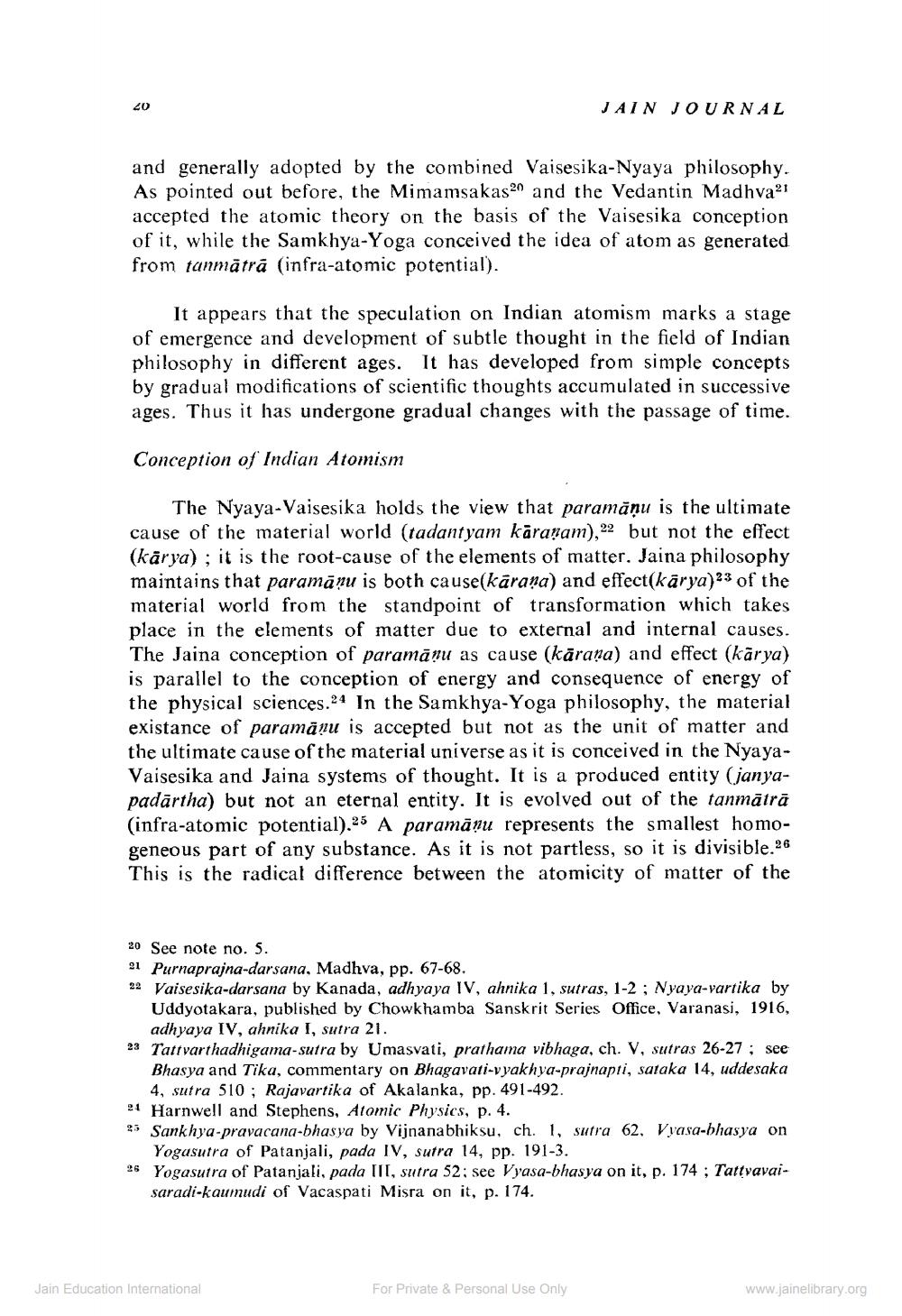________________
JAIN JOURNAL
and generally adopted by the combined Vaisesika-Nyaya philosophy. As pointed out before, the Mimamsakas?" and the Vedantin Madhva?! accepted the atomic theory on the basis of the Vaisesika conception of it, while the Samkhya-Yoga conceived the idea of atom as generated from tanmatrā (infra-atomic potential).
It appears that the speculation on Indian atomism marks a stage of emergence and development of subtle thought in the field of Indian philosophy in different ages. It has developed from simple concepts by gradual modifications of scientific thoughts accumulated in successive ages. Thus it has undergone gradual changes with the passage of time.
Conception of Indian Atomism
The Nyaya-Vaisesika holds the view that paramāņu is the ultimate cause of the material world (tadantyam karanam),22 but not the effect (karya); it is the root-cause of the elements of matter. Jaina philosophy maintains that paramānu is both cause(kārana) and effect(karya)23 of the material world from the standpoint of transformation which takes place in the elements of matter due to external and internal causes. The Jaina conception of paramānu as cause (kāraṇa) and effect (kārya) is parallel to the conception of energy and consequence of energy of the physical sciences.24 In the Samkhya-Yoga philosophy, the material existance of paramānu is accepted but not as the unit of matter and the ultimate cause of the material universe as it is conceived in the NyayaVaisesika and Jaina systems of thought. It is a produced entity (janyapadārtha) but not an eternal entity. It is evolved out of the tanmātrā (infra-atomic potential).25 A paramāņu represents the smallest homogeneous part of any substance. As it is not partless, so it is divisible. 26 This is the radical difference between the atomicity of matter of the
20 See note no. S. 21 Purnaprajna-darsana, Madhva, pp. 67-68. 22 Vaisesika-darsana by Kanada, adhyaya IV, ahnika 1, sutras, 1-2 ; Nyaya-vartika by
Uddyotakara, published by Chowkhamba Sanskrit Series Office, Varanasi, 1916,
adhyaya IV, ahnika I, sutra 21. 23 Tattvarthadhigama-sutra by Umasvati, prathama vibhaga, ch. V, sutras 26-27 ; see
Bhasya and Tika, commentary on Bhagavati-vyakhya-prajnapti, sataka 14, uddesaka
4, sutra 510 ; Rajavartika of Akalanka, pp. 491-492. 21 Harnwell and Stephens, Atomic Physics, p. 4. 25 Sankhya-pravacana-bhasya by Vijnanabhiksu, ch. 1, sutra 62. Vyasa-bhasya on
Yogasutra of Patanjali, pada IV, sutra 14, pp. 191-3. 26 Yogasutra of Patanjali, pada III, sutra 52: see Vyasa-bhasya on it, p. 174 ; Tattvavai
saradi-kaumudi of Vacaspati Misra on it, p. 174.
Jain Education International
For Private & Personal Use Only
www.jainelibrary.org




